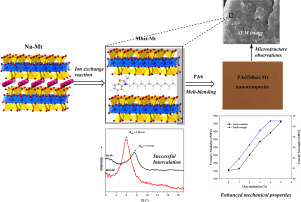当前位置:
X-MOL 学术
›
Appl. Clay. Sci.
›
论文详情
Our official English website, www.x-mol.net, welcomes your
feedback! (Note: you will need to create a separate account there.)
The effect of benzothiazolium surfactant modified montmorillonite content on the properties of polyamide 6 nanocomposites
Applied Clay Science ( IF 5.3 ) Pub Date : 2020-02-01 , DOI: 10.1016/j.clay.2019.105417 Mohamed El Mehdi Mekhzoum , Marya Raji , Denis Rodrigue , Abou el kacem Qaiss , Rachid Bouhfid
Applied Clay Science ( IF 5.3 ) Pub Date : 2020-02-01 , DOI: 10.1016/j.clay.2019.105417 Mohamed El Mehdi Mekhzoum , Marya Raji , Denis Rodrigue , Abou el kacem Qaiss , Rachid Bouhfid

|
Abstract The study of organoclay is a vital subject in current research since various organo-modified clays have become an attractive class of organic–inorganic hybrid materials owing to their potential application as precursors in the field of polymer nanocomposites. In the present investigation, a new benzothiazolium salt, N-dodecyl-2-methylbenzothiazolium iodide (Mbzt) was designed and synthesized for use as sodium montmorillonite (Na Mt) modification by the traditional cation exchange reaction. The successful intercalation of Mbzt surfactant into the montmorillonite interlayer has been confirmed by FTIR, XRD and TGA analysis. The XRD analysis demonstrated that the intercalated surfactant adopted a tilted monolayer arrangement. The resulting benzothiazolium-modified (Mbzt-Mt) displayed a high thermal stability as compared to the unmodified (Na Mt). The desired organoclay was then subsequently mixed with polyamide 6 (PA6) by melt extrusion in a twin-screw extruder. The thermal and morphological properties of the resulting PA6/Mbzt-Mt nanocomposites were evaluated by thermogravimetric analysis (TGA) and scanning electronic microscopy (SEM). TGA analysis reveal that the thermal stability of PA6 nanocomposites slightly decrease (393–391 °C) with particles loading from 1 to 5 wt%, against raw PA6 (407 °C), while an increase in the charred residue up to 5.1% was clearly observed. In addition, a good overall dispersion of the organoclay particles in the PA6 matrix was readily observed by SEM images. The mechanical and rheological properties of nanocomposites were also evaluated. A linear increase in Young's modulus and tensile strength from the use of particles when compared to the neat PA6. In particular, a 26% increase in Young's modulus, a 11.5% increase in tensile strength for the case of PA6 nanocomposites containing 5 wt% of clay as compared to that of pure PA6. From a rheological point of view, the addition of organoclay affect the linear viscoelastic behavior of the PA6 matrix, the viscosity of nanocomposites are higher than that of pure PA6, the organoclays particles restrict the movement of PA6 macromolecular chains, which increases the viscosity. These findings are important and relevant to the elaboration of low-cost organoclay as nano-reinforcement for advanced nanocomposite materials in various application.
中文翻译:

苯并噻唑表面活性剂改性蒙脱石含量对聚酰胺6纳米复合材料性能的影响
摘要 有机粘土的研究是当前研究中的一个重要课题,因为各种有机改性粘土因其作为聚合物纳米复合材料领域的前驱体的潜在应用而成为一类有吸引力的有机-无机杂化材料。在本研究中,设计并合成了一种新的苯并噻唑鎓盐,N-十二烷基-2-甲基苯并噻唑鎓碘化物 (Mbzt),用于通过传统的阳离子交换反应对蒙脱石钠 (Na Mt) 进行改性。FTIR、XRD 和 TGA 分析证实了 Mbzt 表面活性剂成功嵌入蒙脱石夹层中。XRD 分析表明插层表面活性剂采用倾斜的单层排列。与未改性的 (Na Mt) 相比,所得苯并噻唑鎓改性的 (Mbzt-Mt) 显示出高热稳定性。随后在双螺杆挤出机中通过熔融挤出将所需的有机粘土与聚酰胺6(PA6)混合。通过热重分析 (TGA) 和扫描电子显微镜 (SEM) 评估所得 PA6/Mbzt-Mt 纳米复合材料的热学和形态学性质。TGA 分析表明,PA6 纳米复合材料的热稳定性略微降低(393–391 °C),颗粒负载从 1% 到 5 wt%,相对于原始 PA6(407 °C),而烧焦的残留物增加了 5.1%清楚地观察到。此外,通过 SEM 图像很容易观察到有机粘土颗粒在 PA6 基体中的良好整体分散。还评估了纳米复合材料的机械和流变性能。与纯 PA6 相比,使用颗粒后杨氏模量和拉伸强度线性增加。特别是,与纯 PA6 相比,含有 5 wt% 粘土的 PA6 纳米复合材料的杨氏模量增加了 26%,拉伸强度增加了 11.5%。从流变学的角度来看,有机粘土的加入影响了 PA6 基体的线性粘弹性行为,纳米复合材料的粘度高于纯 PA6,有机粘土颗粒限制了 PA6 大分子链的运动,从而增加了粘度。这些发现对于开发低成本有机粘土作为各种应用中先进纳米复合材料的纳米增强材料非常重要且相关。与纯 PA6 相比,使用颗粒后杨氏模量和拉伸强度线性增加。特别是,与纯 PA6 相比,含有 5 wt% 粘土的 PA6 纳米复合材料的杨氏模量增加了 26%,拉伸强度增加了 11.5%。从流变学的角度来看,有机粘土的加入影响了 PA6 基体的线性粘弹性行为,纳米复合材料的粘度高于纯 PA6,有机粘土颗粒限制了 PA6 大分子链的运动,从而增加了粘度。这些发现对于开发低成本有机粘土作为各种应用中先进纳米复合材料的纳米增强材料非常重要且相关。与纯 PA6 相比,使用颗粒后杨氏模量和拉伸强度线性增加。特别是,与纯 PA6 相比,含有 5 wt% 粘土的 PA6 纳米复合材料的杨氏模量增加了 26%,拉伸强度增加了 11.5%。从流变学的角度来看,有机粘土的加入影响了 PA6 基体的线性粘弹性行为,纳米复合材料的粘度高于纯 PA6,有机粘土颗粒限制了 PA6 大分子链的运动,从而增加了粘度。这些发现对于开发低成本有机粘土作为各种应用中先进纳米复合材料的纳米增强材料非常重要且相关。与纯 PA6 相比,使用颗粒的模量和拉伸强度。特别是,与纯 PA6 相比,含有 5 wt% 粘土的 PA6 纳米复合材料的杨氏模量增加了 26%,拉伸强度增加了 11.5%。从流变学的角度来看,有机粘土的加入影响了 PA6 基体的线性粘弹性行为,纳米复合材料的粘度高于纯 PA6,有机粘土颗粒限制了 PA6 大分子链的运动,从而增加了粘度。这些发现对于开发低成本有机粘土作为各种应用中先进纳米复合材料的纳米增强材料非常重要且相关。与纯 PA6 相比,使用颗粒的模量和拉伸强度。特别是,与纯 PA6 相比,含有 5 wt% 粘土的 PA6 纳米复合材料的杨氏模量增加了 26%,拉伸强度增加了 11.5%。从流变学的角度来看,有机粘土的加入影响了 PA6 基体的线性粘弹性行为,纳米复合材料的粘度高于纯 PA6,有机粘土颗粒限制了 PA6 大分子链的运动,从而增加了粘度。这些发现对于开发低成本有机粘土作为各种应用中先进纳米复合材料的纳米增强材料非常重要且相关。与纯 PA6 相比,含有 5 wt% 粘土的 PA6 纳米复合材料的拉伸强度增加了 5%。从流变学的角度来看,有机粘土的加入影响了 PA6 基体的线性粘弹性行为,纳米复合材料的粘度高于纯 PA6,有机粘土颗粒限制了 PA6 大分子链的运动,从而增加了粘度。这些发现对于开发低成本有机粘土作为各种应用中先进纳米复合材料的纳米增强材料非常重要且相关。与纯 PA6 相比,含有 5 wt% 粘土的 PA6 纳米复合材料的拉伸强度增加了 5%。从流变学的角度来看,有机粘土的加入影响了 PA6 基体的线性粘弹性行为,纳米复合材料的粘度高于纯 PA6,有机粘土颗粒限制了 PA6 大分子链的运动,从而增加了粘度。这些发现对于开发低成本有机粘土作为各种应用中先进纳米复合材料的纳米增强材料非常重要且相关。有机粘土颗粒限制了 PA6 大分子链的运动,从而增加了粘度。这些发现对于开发低成本有机粘土作为各种应用中先进纳米复合材料的纳米增强材料非常重要且相关。有机粘土颗粒限制了 PA6 大分子链的运动,从而增加了粘度。这些发现对于开发低成本有机粘土作为各种应用中先进纳米复合材料的纳米增强材料非常重要且相关。
更新日期:2020-02-01
中文翻译:

苯并噻唑表面活性剂改性蒙脱石含量对聚酰胺6纳米复合材料性能的影响
摘要 有机粘土的研究是当前研究中的一个重要课题,因为各种有机改性粘土因其作为聚合物纳米复合材料领域的前驱体的潜在应用而成为一类有吸引力的有机-无机杂化材料。在本研究中,设计并合成了一种新的苯并噻唑鎓盐,N-十二烷基-2-甲基苯并噻唑鎓碘化物 (Mbzt),用于通过传统的阳离子交换反应对蒙脱石钠 (Na Mt) 进行改性。FTIR、XRD 和 TGA 分析证实了 Mbzt 表面活性剂成功嵌入蒙脱石夹层中。XRD 分析表明插层表面活性剂采用倾斜的单层排列。与未改性的 (Na Mt) 相比,所得苯并噻唑鎓改性的 (Mbzt-Mt) 显示出高热稳定性。随后在双螺杆挤出机中通过熔融挤出将所需的有机粘土与聚酰胺6(PA6)混合。通过热重分析 (TGA) 和扫描电子显微镜 (SEM) 评估所得 PA6/Mbzt-Mt 纳米复合材料的热学和形态学性质。TGA 分析表明,PA6 纳米复合材料的热稳定性略微降低(393–391 °C),颗粒负载从 1% 到 5 wt%,相对于原始 PA6(407 °C),而烧焦的残留物增加了 5.1%清楚地观察到。此外,通过 SEM 图像很容易观察到有机粘土颗粒在 PA6 基体中的良好整体分散。还评估了纳米复合材料的机械和流变性能。与纯 PA6 相比,使用颗粒后杨氏模量和拉伸强度线性增加。特别是,与纯 PA6 相比,含有 5 wt% 粘土的 PA6 纳米复合材料的杨氏模量增加了 26%,拉伸强度增加了 11.5%。从流变学的角度来看,有机粘土的加入影响了 PA6 基体的线性粘弹性行为,纳米复合材料的粘度高于纯 PA6,有机粘土颗粒限制了 PA6 大分子链的运动,从而增加了粘度。这些发现对于开发低成本有机粘土作为各种应用中先进纳米复合材料的纳米增强材料非常重要且相关。与纯 PA6 相比,使用颗粒后杨氏模量和拉伸强度线性增加。特别是,与纯 PA6 相比,含有 5 wt% 粘土的 PA6 纳米复合材料的杨氏模量增加了 26%,拉伸强度增加了 11.5%。从流变学的角度来看,有机粘土的加入影响了 PA6 基体的线性粘弹性行为,纳米复合材料的粘度高于纯 PA6,有机粘土颗粒限制了 PA6 大分子链的运动,从而增加了粘度。这些发现对于开发低成本有机粘土作为各种应用中先进纳米复合材料的纳米增强材料非常重要且相关。与纯 PA6 相比,使用颗粒后杨氏模量和拉伸强度线性增加。特别是,与纯 PA6 相比,含有 5 wt% 粘土的 PA6 纳米复合材料的杨氏模量增加了 26%,拉伸强度增加了 11.5%。从流变学的角度来看,有机粘土的加入影响了 PA6 基体的线性粘弹性行为,纳米复合材料的粘度高于纯 PA6,有机粘土颗粒限制了 PA6 大分子链的运动,从而增加了粘度。这些发现对于开发低成本有机粘土作为各种应用中先进纳米复合材料的纳米增强材料非常重要且相关。与纯 PA6 相比,使用颗粒的模量和拉伸强度。特别是,与纯 PA6 相比,含有 5 wt% 粘土的 PA6 纳米复合材料的杨氏模量增加了 26%,拉伸强度增加了 11.5%。从流变学的角度来看,有机粘土的加入影响了 PA6 基体的线性粘弹性行为,纳米复合材料的粘度高于纯 PA6,有机粘土颗粒限制了 PA6 大分子链的运动,从而增加了粘度。这些发现对于开发低成本有机粘土作为各种应用中先进纳米复合材料的纳米增强材料非常重要且相关。与纯 PA6 相比,使用颗粒的模量和拉伸强度。特别是,与纯 PA6 相比,含有 5 wt% 粘土的 PA6 纳米复合材料的杨氏模量增加了 26%,拉伸强度增加了 11.5%。从流变学的角度来看,有机粘土的加入影响了 PA6 基体的线性粘弹性行为,纳米复合材料的粘度高于纯 PA6,有机粘土颗粒限制了 PA6 大分子链的运动,从而增加了粘度。这些发现对于开发低成本有机粘土作为各种应用中先进纳米复合材料的纳米增强材料非常重要且相关。与纯 PA6 相比,含有 5 wt% 粘土的 PA6 纳米复合材料的拉伸强度增加了 5%。从流变学的角度来看,有机粘土的加入影响了 PA6 基体的线性粘弹性行为,纳米复合材料的粘度高于纯 PA6,有机粘土颗粒限制了 PA6 大分子链的运动,从而增加了粘度。这些发现对于开发低成本有机粘土作为各种应用中先进纳米复合材料的纳米增强材料非常重要且相关。与纯 PA6 相比,含有 5 wt% 粘土的 PA6 纳米复合材料的拉伸强度增加了 5%。从流变学的角度来看,有机粘土的加入影响了 PA6 基体的线性粘弹性行为,纳米复合材料的粘度高于纯 PA6,有机粘土颗粒限制了 PA6 大分子链的运动,从而增加了粘度。这些发现对于开发低成本有机粘土作为各种应用中先进纳米复合材料的纳米增强材料非常重要且相关。有机粘土颗粒限制了 PA6 大分子链的运动,从而增加了粘度。这些发现对于开发低成本有机粘土作为各种应用中先进纳米复合材料的纳米增强材料非常重要且相关。有机粘土颗粒限制了 PA6 大分子链的运动,从而增加了粘度。这些发现对于开发低成本有机粘土作为各种应用中先进纳米复合材料的纳米增强材料非常重要且相关。











































 京公网安备 11010802027423号
京公网安备 11010802027423号